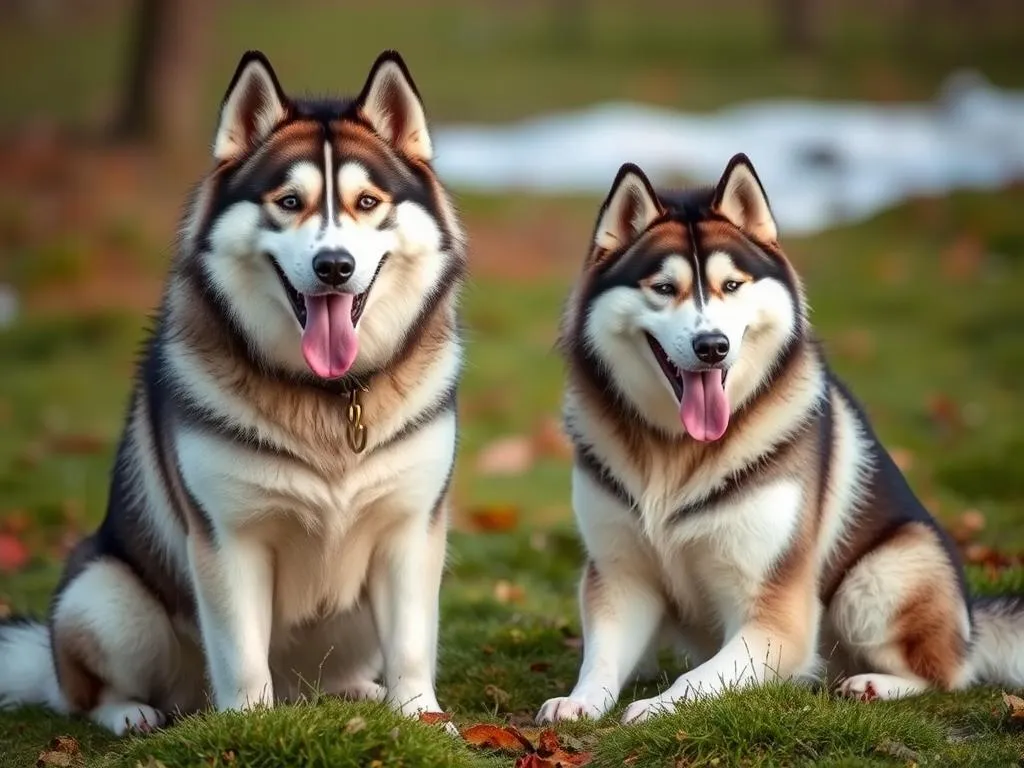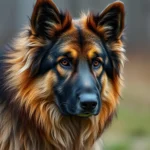
When it comes to choosing a dog, the Alaskan Malamute vs Husky debate often pops up among potential dog owners. Both breeds are known for their striking appearances, friendly dispositions, and strong working abilities. However, they are distinct breeds with unique characteristics that can significantly impact your experience as a dog owner. Understanding these differences is crucial for anyone considering welcoming a new furry friend into their home.
Breed History
Alaskan Malamute
The Alaskan Malamute traces its roots back to the Arctic, where it was developed by the Mahlemut tribe. These dogs were bred primarily for their strength and endurance, making them invaluable for hauling heavy sleds and providing companionship. The breed was essential for survival in harsh climates, and its robust build was a key factor in its effectiveness as a working dog. Over time, the Alaskan Malamute has become a popular family pet, admired for its loyalty and affection.
Culturally, the Alaskan Malamute holds significant importance in indigenous Alaskan communities. It symbolizes resilience and adaptability, reflecting the harsh conditions of the environment where it thrived. The breed’s historical role as a working dog has made it an iconic figure in Alaskan culture.
Siberian Husky
In contrast, the Siberian Husky originates from the northeastern Siberia, developed by the Chukchi people. This breed was also bred for sled pulling, but its primary purpose was to transport goods over long distances in extreme cold. Huskies are known for their incredible stamina and friendly disposition, making them excellent working dogs and companions.
The Siberian Husky is steeped in cultural significance as well. For the Chukchi people, these dogs were not just workers; they were integral to their way of life, participating in hunts and family activities. This deep-rooted connection to human society has contributed to the breed’s popularity beyond its native land.
Physical Characteristics
Size and Weight
When comparing the Alaskan Malamute vs Husky, one of the most noticeable differences is their size.
-
Alaskan Malamute: Males typically weigh between 90-100 pounds, while females range from 75-85 pounds. In terms of height, they stand around 23-25 inches at the shoulder.
-
Siberian Husky: Generally smaller, males weigh between 45-60 pounds, and females are slightly lighter at 35-50 pounds. Huskies stand about 20-24 inches tall at the shoulder.
Coat and Color
Both breeds have double coats, which provide insulation against cold weather, but their coat characteristics differ.
-
Alaskan Malamute: Their thick, coarse outer coat can be various colors, including gray, black, sable, and red, with white markings. Grooming is necessary, especially during shedding seasons, to keep the coat healthy.
-
Siberian Husky: Huskies also come in a variety of colors and patterns, including black, gray, red, and agouti. Their coat is softer and requires regular grooming to manage shedding, particularly in the spring and fall.
Facial Features and Expression
The facial characteristics of these breeds also set them apart.
-
Alaskan Malamute: They have a broad head with a slightly rounded skull, and their eyes are usually brown, giving them a dignified expression. Their ears are erect and slightly rounded at the tips.
-
Siberian Husky: Huskies are known for their striking blue or multi-colored eyes, and they have a more wolf-like appearance. Their face is more narrow, with a well-defined stop and triangular ears that are also erect.
Temperament and Personality
Alaskan Malamute
The Alaskan Malamute is known for being loyal, affectionate, and independent. They often form strong bonds with their families but can be aloof with strangers.
-
General Behavior: Their independent nature can sometimes come across as stubbornness, making them challenging to train without consistency and patience.
-
Interaction with Family and Other Pets: Malamutes are generally good with children and can get along with other pets, especially if socialized early. However, their strong prey drive may lead them to chase smaller animals.
Siberian Husky
On the other hand, the Siberian Husky is playful, energetic, and friendly. They tend to be more social than Alaskan Malamutes.
-
General Behavior: Huskies are known for their playful and mischievous nature. They enjoy being around people and can be quite vocal.
-
Interaction with Family and Other Pets: Huskies are usually good with children and can get along well with other dogs, but their high energy levels can overwhelm less active pets. Early socialization is essential to ensure they develop good manners.
Energy Levels and Exercise Requirements
Alaskan Malamute
The Alaskan Malamute requires a significant amount of exercise and mental stimulation.
-
Daily Exercise Needs: They thrive on physical activities such as hiking, pulling sleds, or participating in dog sports. A minimum of 1-2 hours of exercise daily is recommended to keep them healthy and happy.
-
Mental Stimulation: Engaging in training sessions and interactive games is crucial, as their intelligent minds need challenges to prevent boredom.
Siberian Husky
Similarly, the Siberian Husky has high exercise requirements.
-
Daily Exercise Needs: Huskies also need at least 1-2 hours of vigorous exercise per day. Activities like running, playing fetch, or agility training are excellent for meeting their energy needs.
-
Mental Stimulation: They are intelligent dogs that require mental challenges. Puzzle toys and obedience training can help keep their minds sharp.
Training and Socialization
Alaskan Malamute
Training an Alaskan Malamute can be rewarding but challenging.
-
Training Challenges: Their independent nature may lead to stubbornness, requiring a firm yet gentle approach. Positive reinforcement methods work best, as harsh training can lead to resistance.
-
Socialization Needs: Early socialization is critical to help them become well-rounded pets. Exposure to various environments, people, and animals will help them develop good behavior.
Siberian Husky
Training a Siberian Husky comes with its own set of challenges.
-
Training Challenges: Huskies are known for their intelligence but can also be quite stubborn. Consistency and patience are essential, and training should be fun to keep them engaged.
-
Socialization Needs: Like the Malamute, Huskies benefit from early socialization. Introducing them to different situations and people can help them grow into well-adjusted adults.
Health Considerations
Common Health Issues
Both breeds are generally healthy but can be prone to certain breed-specific health issues.
-
Alaskan Malamute: Common health concerns include hip dysplasia, elbow dysplasia, and certain hereditary conditions like hypothyroidism.
-
Siberian Husky: Huskies may face health issues such as hip dysplasia, cataracts, and progressive retinal atrophy. Regular vet check-ups are essential for early detection.
Lifespan
The average lifespan for both breeds varies slightly.
-
Alaskan Malamute: Typically, Malamutes live around 10-14 years, depending on genetics and care.
-
Siberian Husky: Huskies generally have a lifespan of 12-15 years, often influenced by their diet, exercise, and overall health.
Cost of Ownership
Initial Purchase Price
When considering the Alaskan Malamute vs Husky, the initial purchase price varies.
-
Alaskan Malamute: The average price for a Malamute puppy can range from $800 to $2,000, depending on the breeder’s reputation and the puppy’s lineage.
-
Siberian Husky: Husky puppies typically cost between $600 and $1,500, also influenced by breeder quality and demand.
Ongoing Care Expenses
Ongoing care costs for both breeds can be substantial.
-
Alaskan Malamute: Grooming, food, and health care expenses can range from $100 to $200 per month, depending on the dog’s size and health needs.
-
Siberian Husky: Huskies may incur similar expenses, averaging $80 to $150 per month for food, grooming, and vet visits.
Verdict: Which Breed is Right for You?
Lifestyle Considerations
Choosing between the Alaskan Malamute vs Husky often comes down to lifestyle.
- Active vs. Less Active Owners: If you lead an active lifestyle and enjoy outdoor activities, both breeds can be a great fit. However, if you prefer a more laid-back lifestyle, you may want to consider a different breed.
Space and Environment
Living arrangements play a significant role in your decision.
- Living Arrangements: Alaskan Malamutes and Siberian Huskies thrive in homes with large yards where they can roam and play. While they can adapt to apartment living, they require plenty of exercise and stimulation.
Personal Preferences
Personal traits and family dynamics should also influence your choice.
- Choosing Based on Personal Traits: Consider your family situation, experience with dogs, and whether you can commit to the time and effort necessary for training and exercise.
Conclusion
In summation, both the Alaskan Malamute vs Husky offer unique qualities that can enrich your life. Understanding their histories, physical characteristics, temperaments, energy levels, and care requirements is essential in making an informed decision. Each breed has its advantages and challenges, so it’s vital to consider your lifestyle, living situation, and personal preferences before bringing one of these magnificent dogs into your home. Choosing the right breed is not just about aesthetics; it’s about finding a companion that fits seamlessly into your life.






